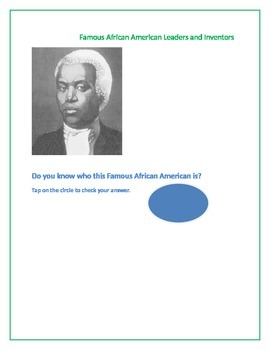African American Leaders and Inventors using Smart Board #2
mary londergan
17 Followers
Grade Levels
2nd - 6th, Homeschool
Subjects
Resource Type
Standards
CCSSRI.2.1
CCSSRI.2.3
CCSSRI.2.5
CCSSRI.2.6
CCSSRI.2.7
Formats Included
- NOTEBOOK (SMARTboard) File
Pages
18 pages
mary londergan
17 Followers
Description
African American Leaders and Inventors using Smart Board #2 focuses on ten prominent men and women including: Benjamin Banneker, Rebecca Cole, Archibald Alexander, Benjamin Bradley, Thomas L. Jennings, Edward A. Bouchet, Daniel Hale Williams, Norbert Rillieux, David N. Crosthwait, and Fredrick M. Jones. This group was born from 1731 to 1893. This is an 18 page Smart Board lesson and has fast facts on each person as well as a photo. In fact, on the first page you will see an activity to engage students immediately with a photo and a question asking who the famous person is (with an interactive answer included.) Additionally it has writing extensions and game formats using Timeliner, Multiple choice, Vortex, Keyword match, and Image match from Smart Board. In the multiple choice game format there is a question and answer on each of the ten Famous African Americans. In Vortex all ten of the Famous Americans are listed and need to be sorted into :”holds a patent” or “does not hold a patent” This activity includes two timeline activities. One is involving dates of patents, and the other is on birthdates of all ten African Americans. There are six total writing extensions using Bloom’s taxonomy at the highest level. One question is “Justify who has had the most significant impact on American history of this group of very powerful African Americans. “
Total Pages
18 pages
Answer Key
N/A
Teaching Duration
1 month
Report this resource to TPT
Reported resources will be reviewed by our team. Report this resource to let us know if this resource violates TPT’s content guidelines.
Standards
to see state-specific standards (only available in the US).
CCSSRI.2.1
Ask and answer such questions as who, what, where, when, why, and how to demonstrate understanding of key details in a text.
CCSSRI.2.3
Describe the connection between a series of historical events, scientific ideas or concepts, or steps in technical procedures in a text.
CCSSRI.2.5
Know and use various text features (e.g., captions, bold print, subheadings, glossaries, indexes, electronic menus, icons) to locate key facts or information in a text efficiently.
CCSSRI.2.6
Identify the main purpose of a text, including what the author wants to answer, explain, or describe.
CCSSRI.2.7
Explain how specific images (e.g., a diagram showing how a machine works) contribute to and clarify a text.


